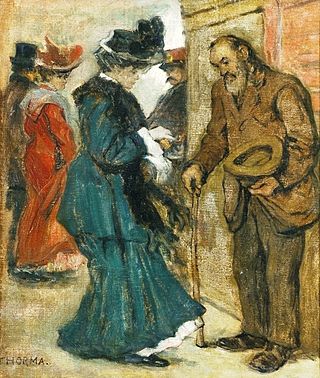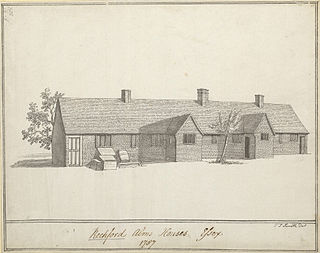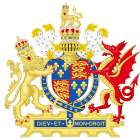
Alms are money, food, or other material goods donated to people living in poverty. Providing alms is often considered an act of charity. The act of providing alms is called almsgiving.

The English Poor Laws were a system of poor relief in England and Wales that developed out of the codification of late-medieval and Tudor-era laws in 1587–1598. The system continued until the modern welfare state emerged after the Second World War.

John Roy Hooper was an English churchman, Anglican Bishop of Gloucester, later of Worcester and Gloucester, a Protestant reformer and a Protestant martyr. A proponent of the English Reformation, he was executed for heresy by burning during the reign of Queen Mary I.

An almshouse is charitable housing provided to people in a particular community, especially during the Middle Ages. They were often targeted at the poor of a locality, at those from certain forms of previous employment, or their widows, and at elderly people who could no longer pay rent, and are generally maintained by a charity or the trustees of a bequest. Almshouses were originally formed as extensions of the church system and were later adapted by local officials and authorities.

Begging is the practice of imploring others to grant a favor, often a gift of money, with zero expectation of reciprocation. A person doing such is called a beggar or panhandler. Beggars may operate in public places such as transport routes, urban parks, and markets. Besides money, they may also ask for food, drink, cigarettes or other small items.
The Charity Organisation Societies were founded in England in 1869 following the 'Goschen Minute' that sought to severely restrict outdoor relief distributed by the Poor Law Guardians. In the early 1870s a handful of local societies were formed with the intention of restricting the distribution of outdoor relief to the elderly.

A Caveat or Warning for Common Cursitors, vulgarly called vagabonds was first published in 1566 by Thomas Harman, and although no copies of that edition survive, it must have been popular, because two printers were punished by the Stationers' Company in 1567 for pirated editions. Two editions were published in 1568, and a revised edition in 1573. It is one of the fundamental texts for rogue literature. Harman is one of the first writers to use the word rogue, which was adopted in the Poor Law legislation of 1572.
The Mid-Tudor Crisis denotes the period of English history between 1547 and 1558, when, it has been argued by Whitney Jones and others, English government and society were in imminent danger of collapse in the face of a combination of weak rulers, economic pressures, a series of rebellions, and religious upheaval in the wake of the English Reformation, among other factors. Recently, historians such as David Loades have disputed the underlying assumptions of the thesis and have argued that this period was actually one of success and even outright achievements.

The Poor Relief Act 1601 was an Act of the Parliament of England. The Act for the Relief of the Poor 1601, popularly known as the Elizabethan Poor Law, "43rd Elizabeth" or the Old Poor Law was passed in 1601 and created a poor law system for England and Wales.

In English and British history, poor relief refers to government and ecclesiastical action to relieve poverty. Over the centuries, various authorities have needed to decide whose poverty deserves relief and also who should bear the cost of helping the poor. Alongside ever-changing attitudes towards poverty, many methods have been attempted to answer these questions. Since the early 16th century legislation on poverty enacted by the Parliament of England, poor relief has developed from being little more than a systematic means of punishment into a complex system of government-funded support and protection, especially following the creation in the 1940s of the welfare state. Poor relief will control crime if adequately given.

Vagrancy is the condition of homelessness without regular employment or income. Vagrants usually live in poverty and support themselves by begging, scavenging, petty theft, temporary work, or social security. Historically, vagrancy in Western societies was associated with petty crime, begging and lawlessness, and punishable by law with forced labor, military service, imprisonment, or confinement to dedicated labor houses.
The Tudor poor laws were the laws regarding poor relief in the Kingdom of England around the time of the Tudor period (1485–1603). The Tudor Poor Laws ended with the passing of the Elizabethan Poor Law in 1601, two years before the end of the Tudor dynasty, a piece of legislation which codified the previous Tudor legislation.

The Rough Wooing, also known as the Eight Years' War, was part of the Anglo-Scottish Wars of the 16th century. Following its break with the Catholic Church, England attacked Scotland, partly to break the Auld Alliance and prevent Scotland being used as a springboard for future invasion by France, partly to weaken Scotland, and partly to force the Scottish Parliament to confirm the existing marriage alliance between Mary, Queen of Scots, and the English heir apparent Edward, son of King Henry VIII, under the terms of the Treaty of Greenwich of July 1543. An invasion of France was also contemplated. Henry declared war in an attempt to force the Scottish Parliament to agree to the planned marriage between Edward, who was six years old at the start of the war, and the infant queen, thereby creating a new alliance between Scotland and England. Upon Edward's accession to the throne in 1547 at the age of nine, the war continued for a time under the direction of the Duke of Somerset, before Somerset's removal from power in 1549 and replacement by the Duke of Northumberland, who wished for a less costly foreign policy than his predecessor. It was the last major conflict between Scotland and England before the Union of the Crowns in 1603.
The Catholic Church operates numerous charitable organizations.

The Act for Punishment of Sturdy Vagabonds and Beggars was an act passed in Tudor England by Henry VIII. It is part of the Tudor Poor Laws. It was the earliest English Poor Law to provide for structured collections for the poor.

The Vagabonds Act 1547, also known as the Vagrancy Act 1547, was a statute passed in England by King Edward VI and his Lord Protector, Edward Seymour. It provided that vagabonds could be enslaved for two years and continued weekly parish collections for the poor. The enslaved vagabonds were to be fed bread and water or small drink and were allowed to be worked by beating, chaining, or other methods the master may choose. Vagabond slaves were allowed to be bought and sold just as other slaves. Also, should no private man want the vagabond slave, the slave was to be sent to their town of birth and be forced to work as a slave for that community. Vagabond children could be claimed as "apprentices" and be held as such until the age of 24 if a boy, or the age of 20 if a girl. Should they attempt to escape this apprenticeship, they were subject to enslavement for the remainder of the apprenticeship.

The Poor Act 1555 was a law passed in England by Queen Mary I. It is a part of the Tudor Poor Laws.

The Poor Act 1562 or Act for the Relief of the Poor was a law passed in England under Queen Elizabeth I. It is a part of the Tudor Poor Laws.

The Vagabonds Act 1572 or the Vagabonds, etc. Act 1572 was a law passed in England under Queen Elizabeth I. It is a part of the Tudor Poor Laws and a predecessor to the Elizabethan Poor Laws.
Modern scholars of ancient Rome have found difficulty in defining who was considered to be living in poverty due to their lack of significant coverage in the historical record, and the difficulty in defining the lines between poverty and middle class. Roman writers describe the poorer parts of the population as unvirtuous and immoral masses who were threats to the nation and unconcerned with the values of the Roman world. Ancient Roman Christian depictions tend to depict the poor as more sympathetic and often call for the wealthy to help them. There were other efforts to help the poor, such as the Cura Annonae, a policy which redistributed grain. The Roman poor also had limited rights. They were unable to access political offices, had higher tax rates, and were unable to afford most status symbols.













